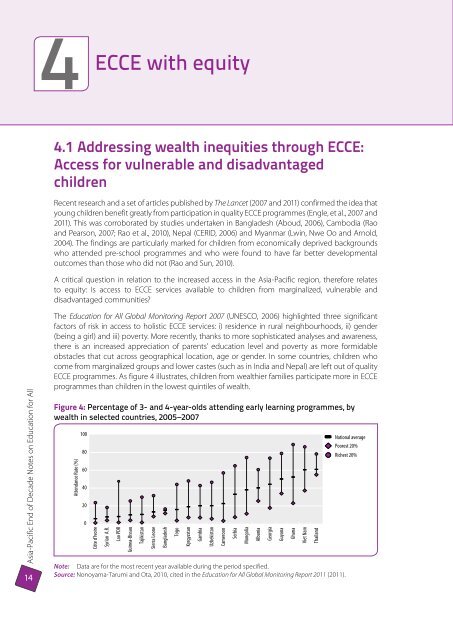EFA Goal 1: Early childhood care and education; Asia ... - Unicef
EFA Goal 1: Early childhood care and education; Asia ... - Unicef
EFA Goal 1: Early childhood care and education; Asia ... - Unicef
Create successful ePaper yourself
Turn your PDF publications into a flip-book with our unique Google optimized e-Paper software.
4<br />
ECCE with equity<br />
4.1 Addressing wealth inequities through ECCE:<br />
Access for vulnerable <strong>and</strong> disadvantaged<br />
children<br />
Recent research <strong>and</strong> a set of articles published by The Lancet (2007 <strong>and</strong> 2011) confirmed the idea that<br />
young children benefit greatly from participation in quality ECCE programmes (Engle, et al., 2007 <strong>and</strong><br />
2011). This was corroborated by studies undertaken in Bangladesh (Aboud, 2006), Cambodia (Rao<br />
<strong>and</strong> Pearson, 2007; Rao et al., 2010), Nepal (CERID, 2006) <strong>and</strong> Myanmar (Lwin, Nwe Oo <strong>and</strong> Arnold,<br />
2004). The findings are particularly marked for children from economically deprived backgrounds<br />
who attended pre-school programmes <strong>and</strong> who were found to have far better developmental<br />
outcomes than those who did not (Rao <strong>and</strong> Sun, 2010).<br />
A critical question in relation to the increased access in the <strong>Asia</strong>-Pacific region, therefore relates<br />
to equity: Is access to ECCE services available to children from marginalized, vulnerable <strong>and</strong><br />
disadvantaged communities?<br />
<strong>Asia</strong>-Pacific End of Decade Notes on Education for All<br />
14<br />
The Education for All Global Monitoring Report 2007 (UNESCO, 2006) highlighted three significant<br />
factors of risk in access to holistic ECCE services: i) residence in rural neighbourhoods, ii) gender<br />
(being a girl) <strong>and</strong> iii) poverty. More recently, thanks to more sophisticated analyses <strong>and</strong> awareness,<br />
there is an increased appreciation of parents’ <strong>education</strong> level <strong>and</strong> poverty as more formidable<br />
obstacles that cut across geographical location, age or gender. In some countries, children who<br />
come from marginalized groups <strong>and</strong> lower castes (such as in India <strong>and</strong> Nepal) are left out of quality<br />
ECCE programmes. As figure 4 illustrates, children from wealthier families participate more in ECCE<br />
programmes than children in the lowest quintiles of wealth.<br />
Figure 4: Percentage of 3- <strong>and</strong> 4-year-olds attending early learning programmes, by<br />
wealth in selected countries, 2005–2007<br />
Attendance Rate (%)<br />
100<br />
80<br />
60<br />
40<br />
20<br />
0<br />
Côte d'Ivoire<br />
Syrian A.R.<br />
Lao PDR<br />
Guinea-Bissau<br />
Tajikistan<br />
Sierra Leone<br />
Bangladesh<br />
Togo<br />
Kyrgyzstan<br />
Gambia<br />
Note: Data are for the most recent year available during the period specified.<br />
Source: Nonoyama-Tarumi <strong>and</strong> Ota, 2010, cited in the Education for All Global Monitoring Report 2011 (2011).<br />
Uzbekistan<br />
Cameroon<br />
Serbia<br />
Mongolia<br />
Albania<br />
Georgia<br />
Guyana<br />
Ghana<br />
Viet Nam<br />
Thail<strong>and</strong><br />
National average<br />
Poorest 20%<br />
Richest 20%

















